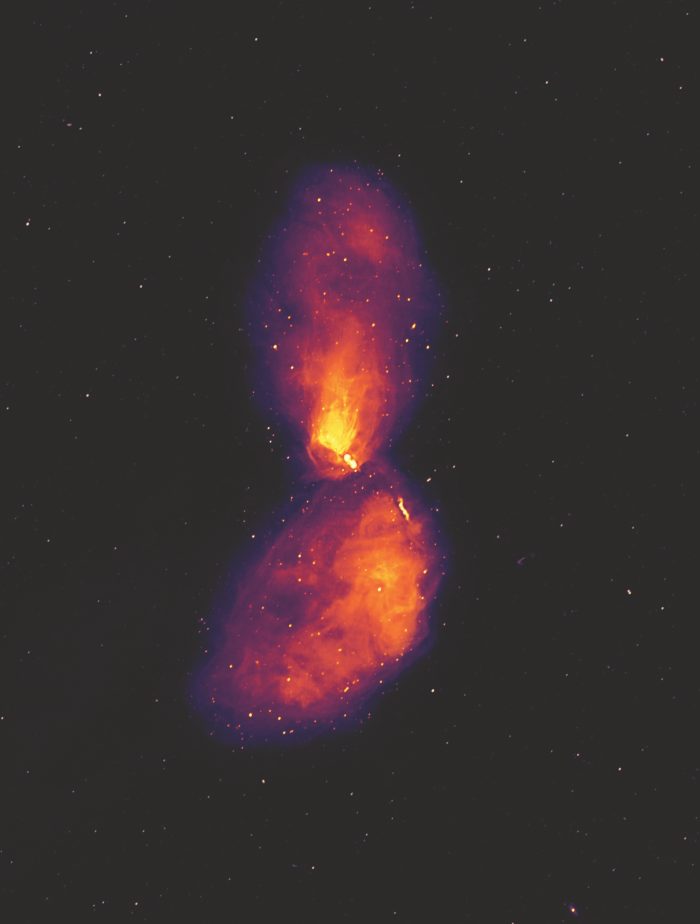As the old adage goes: sometimes it’s better to look at the big picture.
This wisdom is certainly not lost on the field of astronomy.
Putting together a high-resolution image of a large object in the sky, such as a galaxy, is no walk in the cosmic park. Sometimes, astronomers have trouble doing so as some of the telescopes they have access to are limited in fields of vision, posing vexing problems when they have to stitch various datasets together to get the overall picture of a target galaxy.
And this is why a recent study performed by International Centre for Radio Astronomy Research (ICRAR) researchers is so impressive. They’ve captured the most comprehensive image of radio emission from the closest actively feeding supermassive black hole, in the galaxy Centaurus A, about 12 million light-years from Earth.
It’s also a sight to behold. Jets spat out by the black hole, as it gobbles up anything within its vicinity, span more than 16 full Moons laid side by side. Extend your arm, spread out your fingers, and that’s how huge Centaurus A would appear in the sky (if you somehow developed to superability to see in radio wavelengths).

The image of the Centaurus A galaxy at radio wavelengths, revealing vast lobes of plasma that reach far beyond the visible galaxy, which occupies only a small patch at the centre of the image. The dots in the background are not stars, but radio galaxies much like Centaurus A, at far greater distances. Photo credits: Ben McKinley/Curtin and Connor Matherne, Louisiana State University.
Brains and brawn.
Led by Dr Benjamin McKinley and John Curtin Distinguished Professor Steven Tingay from the Curtin University node of ICRAR, the research work, published in Nature Astronomy, is the first-of-its-kind to fit the entire Centaurus A galaxy structure in a single observation (pictured above). This achievement could be partly ascribed to some of the benefits of the radio telescope they used – the Murchison Widefield Array (MWA), a precursor to the multi-billion-dollar Square Kilometre Array (SKA) project. “Due to the MWA’s extremely large field-of-view, or the amount of sky it can cover in a single observation, it’s plausible to produce a really good image, because you are not trying to separately calibrate and stitch together the results of multiple observations,” explained Professor Tingay. “The MWA also has many antennas, which means it can produce high fidelity images, allowing us to recover the complex structures of Centaurus A on multiple scales accurately.
And of course, no matter how advanced the machine is, this work won’t be possible without the brilliance of the brain behind it. Dr McKinley has painstakingly spent an unimaginable amount of time testing and optimising a plethora of calibration and imaging techniques to better process the outpour of data from the MWA. His hard work has definitely paid off.
Piecing the cosmic puzzle together.
With the ability to visualise the structure of Centaurus A in much finer detail via radio observations, the ICRAR researchers combined the MWA data with other datasets from X-ray- and optical-based telescopes, enabling them to extract a treasure trove of information from the black hole at the heart of the galaxy to the furthest reaches of radio emission seen with the MWA.
Like pieces of a cosmic puzzle, the research team was able to link one piece of information to another to concoct a model that could describe how energy and matter circulate in Centaurus A, originating from the black hole system and swirling out into the galaxy and, eventually, back to the central regions.
Apart from corroborating a novel theory called “Chaotic Cold Accretion”, Professor Tingay also said lessons from this study could be applied to the billions of other galaxies in the Universe. “I studied the black hole system in Centaurus A for my PhD thesis 30 years ago and have been at it on and off ever since – this is the first time I’ve seen all the data come together convincingly to tell such a story,” added Professor Tingay.
Supercomputers turbocharge space research in astronomical proportions.
Data from the MWA also came in a deluge. Because of the MWA’s wide field-of-view and its sheer number of antennas, as well as depending on how it’s configured for observations, data rates could be 100 gigabytes per second or higher. Since its operation in 2013, the research team has amassed 40 petabytes of data from the MWA, which is stored and processed using supercomputers onboarded with efficient and optimised algorithms.
Being able to handle and harness the sea of data from the MWA with the help of high-performance computing has given ICRAR researchers the confidence to prepare for the data requirements of the SKA. Planned for completion within the next decade, the SKA could open a window into the first stars and galaxies formed hundreds of millions of years after the Big Bang – an epoch that remains unchartered territory for humankind. Getting a grasp on the Epoch of Reionisation could allow scientists to piece together how planets, stars, galaxies and life, as we know it, came about.
“I like the creative aspect of science and coming up with ways to look at the Universe that haven’t been thought of before,” said Professor Tingay. “The sense of wonder at the scale and complexity of the Universe, and the tantalising prospect that science can seek to explain that complexity with theories and models that can be described mathematically, still blows my mind.”






























